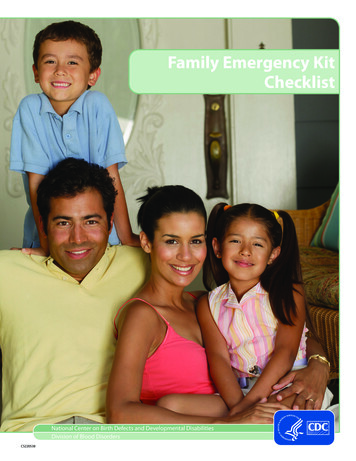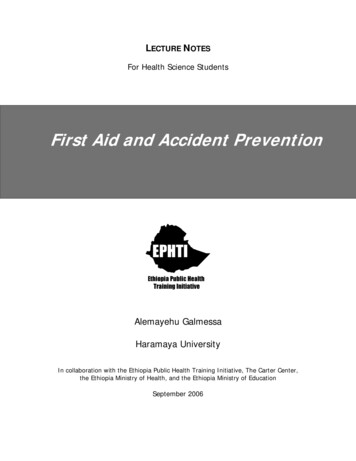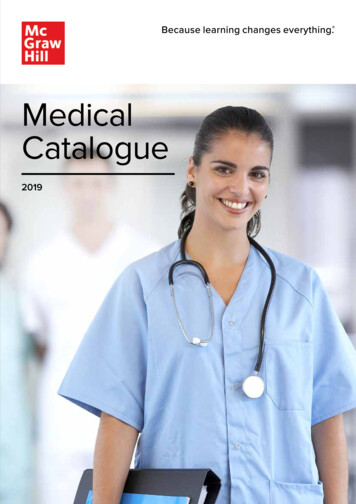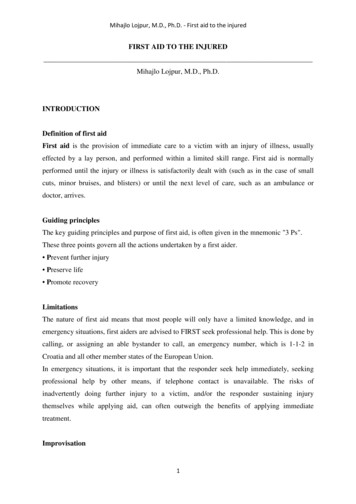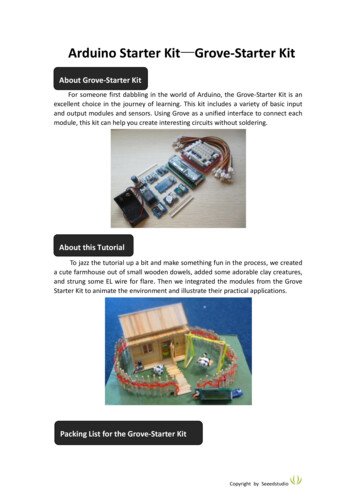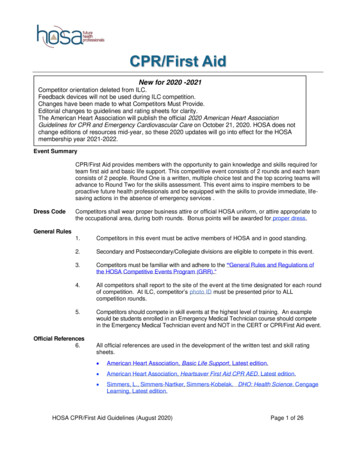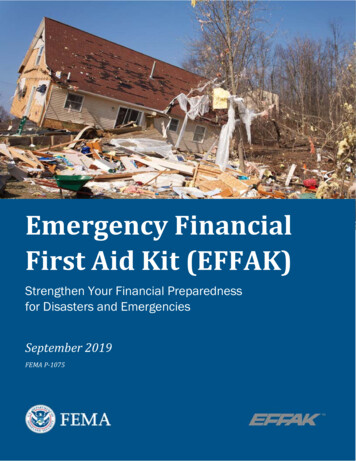
Transcription
Emergency FinancialFirst Aid Kit (EFFAK)Strengthen Your Financial Preparednessfor Disasters and EmergenciesSeptember 2019FEMA P-1075
The Emergency Financial First Aid Kit is available for free from the Federal Emergency Management Agency(FEMA). Call (800) 480–2520 and ask for publication number P-1075. It is also available as a free downloadonline at: www.ready.gov/financialpreparedness and at www.operationhope.org.
Strengthen Your FinancialPreparedness for Emergencies Bigand SmallWhen it comes to emergencies, Americans face more than just earthquakes, tornadoes, and hurricanes. Wealso deal with flat tires, broken water heaters, and sudden medical expenses. Both big disasters andunexpected bills take time, money, and resources away from other priorities. So why aren’t we doing more toget prepared?Studies tell us income is often the most important factor in individual and family preparedness. Researchshows that as an individual’s income goes up, they are more likely to take action to prepare. However, wealso know that as a person’s income decreases, they are less likely to set aside money for emergencies. So, itis clear that a lack of income and savings is a major obstacle to building a rainy-day fund, stockpilingsupplies, or buying insurance.Since 2004, Operation HOPE and FEMA have been regularly collaborating to build financial preparednessthrough the Emergency Financial First Aid Kit (EFFAK). We listened to the feedback we received fromfamilies, community leaders, and financial experts to make this document as useful as possible. The EFFAKcan help you start to prepare by offering guidance on organizing and securing important documents. Thisnew edition of the EFFAK also provides important advice on managing finances, offers insights on dealingwith credit scores, and describes what to expect should a disaster strike your community. All of this will helpfamilies prepare today for both the big incidents and minor emergencies.As individuals and as a nation, we have to do more to prepare for the disasters and emergencies we face. Thisincludes learning basic skills that could save someone’s life after an accident, or practicing emergencycommunications plans with loved ones. It means talking to co-workers about how to get back to businessquickly and safely after a disaster. But it all starts with each of us knowing how to manage our finances.Individuals and families must have a financial plan to face emergencies, big and small. Only then can we builda true culture of preparedness in every home and community across America. We thank you for being a partof this effort.Daniel Kaniewski, PhDDeputy Administrator for ResilienceFederal Emergency Management AgencyJohn Hope BryantCEO and FounderOperation HOPE, Inc.
Table of ContentsOverview.1Financial Wellness .1Four Simple Steps to Financial Preparedness . 2EFFAK Checklists and Forms . 5Household Identification. 6Household Information . 7Financial and Legal Documentation . 11Financial Account Information . 15Medical Information. 18Household Contacts. 20Protecting Your Information . 23Helpful Tips to Protect Your Identity and Important Information . 23Keeping Your Electronic Records Safe . 23Tips on Passwords and PINs . 24What to Do if Your EFFAK Is Stolen . 24Other Steps for Preparing . 25Review Operation HOPE’s Personal Disaster Preparedness Guide . 25Visit Ready.gov . 25Get Involved in Your Community’s Preparedness Activities . 25Download the FEMA Mobile App . 26Follow Tips for Employers and Business Owners . 26If Disaster Strikes . 28Disaster Assistance Resources. 28What Information Do I Need to Apply? . 28Beware of Scams . 29FEMA Tips to Safeguard Against Disaster-Related Fraud . 29Additional Resources. 30Helpful Organizations and Resource Pages . 30Additional References and Tools . 30EFFAK Partners. 31About Operation HOPE, Inc. . 31About the Financial Literacy and Education Commission. 31Notice . 32
Use of the Emergency Financial First Aid Kit . 32Department of Homeland Security Visual Identities . 32No Endorsement . 32Disclaimer . 32
5 - Emergency Financial First Aid Kit
OverviewIf a disaster or other emergency strikes your community, you may onlyhave seconds or minutes to react. In those critical moments, your focuswill be on your family’s safety. Once the threat of harm has passed, havingyour homeowners or renters insurance policy, bank account information,and other household records and contacts will be very important as youbegin the recovery process. The Emergency Financial First Aid Kit(EFFAK) can help you be ready.The nonprofit organization Operation HOPE, in partnership with the Federal Emergency ManagementAgency (FEMA), created the EFFAK in 2004 to help individuals and families collect and organize criticalfinancial, medical, and household contact information.After reading the EFFAK and filling out the included checklists and forms, you will have a centralized recordof essential household information whenever you need it. This will give you peace of mind, as you will bemore prepared and capable of rebuilding your life if you ever find yourself impacted by a disaster. This guidealso offers suggestions on safeguarding and storing your EFFAK, as well as information on protecting yourfamily, property, and other resources.The EFFAK includes checklists of important documents and forms to capture information vital for disasterrecovery that fall into the following four categories: Household Identification Financial and Legal Documentation Medical Information Household ContactsIf you have questions or need assistance completing your EFFAK, call (888) 388–HOPE (4673). For moreinformation on HOPE Coalition America, visit: www.operationhope.org. For information on personaldisaster preparedness or FEMA disaster assistance, visit: www.ready.gov andwww.disasterassistance.gov.Financial WellnessBefore you take the first steps to becoming financially prepared, you should have basic knowledge of yourfinances. Financial literacy is the ability to make informed decisions in managing your financial resourcesand making smart choices on how to spend your money, which can empower you to plan for emergenciesand disasters.The best way to plan for the unexpected expenses that may result after a disaster is to start saving today.Saving money can help you and your family avoid taking on more debt to respond to the costs of rebuildingyour life after an emergency. To learn more about saving visit: www.mymoney.gov/save-invest.1 - Emergency Financial First Aid Kit
Four Simple Steps to Financial Preparedness1. Assess and Compile: Gather your important financial documents and contacts. Complete and date all the forms in the EFFAK. Use the checklists to understand the documentation that you should collect. If you do not have an original version of a document, contact the appropriate company or agency toobtain a copy. If you receive paper checks for any of your Federalbenefits, consider enrolling in automatic benefitsthrough Go Direct(www.fiscal.treasury.gov/GoDirect/). If you receive paper checks from your employer,consider requesting direct deposit or prepaid debitcards. Print or download statements of any bills that youpay automatically, such as rent or mortgagepayments, utilities, loan payments, and membershipfees. Download any banking or bill pay mobileapplications to your smart phone or device for anybills that you pay online. This will allow you toconsider these costs without the need to refer orsort through paper statements. Take photographs or record a video of the rooms in your home and any valuable belongings, as well asthe important documents listed in your EFFAK. Include copies of these records with either your paperor electronic version of the EFFAK. Keep some cash in the same safe location as your EFFAK to pay for emergency purchases in the eventthat ATMs are not functioning or banks are closed. The amount of cash should be based on the basicneeds of your family, including food, gas, and other things you use on a day-to-day basis. Know your FICO Score, which is a type of credit score that lenders use to determine the risk of offeringcredit to a borrower. Knowing your FICO score will allow you to take action if it needs to be improvedin order to prepare for emergency borrowing.2. Review: Review your insurance policies and financial paperwork to be sure that they are still accurateand current. If you own a home or a car, ensure that your homeowners and auto insurance coverage is enough tosupport you in an emergency. If you rent, ensure that your lease reflects your current rent and verify that your renters insurance isup-to-date. Visit www.usa.gov/property-insurance for additional tips on homeowners and renters insurance. The EFFAK will help you to identify any important personal documents or types of insurance (e.g. awill, living will, life insurance policy, or health insurance plan) that you do not currently have.Consider taking the steps to set up these items.2 - Emergency Financial First Aid Kit
3. Safeguard: Store paper and electronic copies of all files in safe locations. Consider storing paper copies of important documents at home in a fireproof and waterproof box orsafe, in a bank safe deposit box, or with a trusted friend or relative. If you are using a safe deposit box,you may want to ask your bank or check state laws to confirm who can and cannot access the safedeposit box if the owner dies or cannot access it themselves due to illness. For electronic copies of important documents, store them in a password-protected format on aremovable flash or external hard drive in your fireproof and waterproof box or safe. You can alsoconsider using a secure offsite storage service. For more steps on how to address your financial needs after a disaster, visit the Consumer FinancialProtection Bureau at: www.consumerfinance.gov/hurricanefinancialtoolkit. If you bank or pay your bills electronically, we recommend printing your account records to includewith your EFFAK or download your bank’s banking app to keep track of statements every few months. File living wills and advanced directives with hospitals and primary care doctors. If you have a lawyer, financial advisor, or trusted family member or friend, you may want to providehim or her with a paper copy of your EFFAK in a sealed envelope. Provide instructions that theyshould only open the envelope with your approval or the approval of someone whom you have chosenin the event you cannot make decisions on your own. These trusted people can be your next of kin orsomeone you have allowed to act on your behalf (known as power of attorney).4. Update: Revisit and update your EFFAK regularly. Updates are especially important when significantchanges in your life occur. Suggested times when you should review your EFFAK: During tax preparation time At the start or end of daylight savings time Around your birthday At the start of a new year Times when you will need to change your EFFAK as soon as possible: When you change your insurance provider When there is a change in residence When you purchase a home or rent an apartment When you open or close bank accounts When you have a change in marital status When you have a child When your child changes schools During retirement planning When there is a death within the household3 - Emergency Financial First Aid Kit
4 - Emergency Financial First Aid Kit
EFFAK Checklists and FormsThis section discusses the following four types of key records and contactinformation: Household IdentificationFinancial and Legal DocumentationMedical InformationHousehold ContactsEach section includes checklists and contact forms to help you collect andassemble your relevant documents and information.Each checklist includes the following columns: Type of Document: This column provides a list of the specific documents for the category (e.g.,driver’s license, bank statements, and health insurance cards). Have: Check the box in this column if you have either a paper or electronic copy of the listeddocument. N/A (Not Applicable): Check the box in this column if you do not need this document or if it does notapply to you, your family, or your household. Remember to review your checklist and updatedocuments if your household circumstances change. Date Added/Updated: Enter the date in this column when you add the paper and/or electronic copyof a document to your EFFAK. This information will serve as a useful reference point to remind youwhen it is time to review or update the document. You can then enter the new date in this columnwhen you review your EFFAK or make updates. Tips and Links: This column provides additional details about certain documents, as well assuggestions and links on how to contact agencies or organizations to request paper or electroniccopies of your documents.Consider the following when using the EFFAK checklists: When you complete the first two sections—Household Identification and Financial and LegalDocumentation—you will have the information needed to apply for FEMA disaster assistance. Forinformation on personal disaster preparedness or FEMA disaster assistance, visit: www.ready.govand www.disasterassistance.gov. For more information on how to prepare your small business fordisaster, visit: www.sba.gov/emergencypreparedness and www.ready.gov/business. You may not require all documents listed in the EFFAK checklists as they may not be relevant to you,your family, or your household. If you identify an important document that you do not currently have, contact the appropriatecompany or agency to obtain a copy of the document.5 - Emergency Financial First Aid Kit
If the document is an item that you normally carry with you (e.g., an insurance card or military ID thatyou keep in your wallet or purse), make a copy of the item and store that copy with your EFFAK.Household IdentificationUse this section to write down important information about your household. This information can help youto: Prove the identity of all household members after a disaster strikes; Maintain or re-establish contact with your family or other members of your household; Maintain contact with your employer or the employers of others in your household; and Apply for FEMA disaster assistance, if eligible (along with the information contained in the Financialand Legal Documentation section).Checklist of Important Documents: Personal and Family InformationType of DocumentHaveN/ADriver’s licenseDate Added/UpdatedIDENTIFICATION DOCUMENTSTips and LinksPhotocopy the front and back.Other photo IDPhotocopy the front and back.Marriage licenseYou can get copies of birth, adoption, death, marriage, anddivorce certificates from your state health or social servicesadministration office for a small fee. The Centers for DiseaseControl and Prevention (CDC) maintains a state-by-statecontact list at: www.cdc.gov/nchs/w2w/.Birth certificate(s)/adoption papers/childcustody documentsDivorce decreeSocial Security card(s)Child identity cards/dental records/DNA swabsPassport/Green CardNaturalization documents6 - Emergency Financial First Aid KitIf you need a new card or a replacement card, call your localSocial Security Administration (SSA) office for assistance at(800) 772-1213 and tell the operator where you live. Tolocate a nearby office, visit:https://secure.ssa.gov/ICON/main.jsp.Make sure that you have your children’s identificationrecords, including recent photographs, child identity cardswith fingerprints, dental records (typically stored by dentalcare providers), or DNA swabs.Photocopy the first two pages of your passport or front andback of your Green Card. Having a copy of your passport orGreen Card will make getting a replacement quicker, ifneeded. Information about applying for and renewing apassport is available at: www.travel.state.gov/passports,or you can call the National Passport Information Center at(877) 487–2778. Information about applying for, renewing,and replacing a Green Card is available at:www.uscis.gov/greencard.Information on U.S. Citizenship and Immigration Services isavailable at: www.uscis.gov. Naturalization documents arethe only acceptable proof of citizenship for individuals notborn in the United States: www.uscis.gov.
Checklist of Important Documents: Personal and Family InformationType of DocumentCurrent military IDHaveDate Added/UpdatedMILITARY/SERVICE INFORMATIONN/AMilitary discharge record(DD 214)PETSPet ID tagsProof of pet ownership(e.g. photos of owners withpets, registration papers)Tips and LinksIf you are a veteran, keep copies of your DD 214, which isyour military discharge form. You can find copies bycontacting the U.S. National Archives and RecordsAdministration at (866) 272–6272 or by accessing Veterans’Records online at: www.archives.gov/veterans.Ensure that you have a copy of your pet’s ID tag numbers andmicrochip account information, if your pet has one. Also,include a current photograph of you with your pet.Pet microchip informationAn emotional support letter is a document provided by alicensed mental health professional that confirms your needfor the support animal and states that you are under the careof a licensed doctor or therapist who has prescribed to youan emotional support animal.Emotional support letterThere are no legal requirements for individuals to have thisdocumentation. However, keep in mind that in the event ofan emergency, shelters may need paperwork to differentiatebetween pets, emotional support animals, and serviceanimals you have with you.Certification for serviceanimalsHousehold InformationBecause every household is different, you will need to customize these forms to meet your needs. Forexample, if someone in your household has more than one job, be sure to write down contact information forsomeone at each job.YOUR NAMELast Name:Date of Birth:First Name:Middle Name:Place of Birth:RESIDENCEAddress:City:Home Phone:Email:Apt.:State:Cell Phone:Other:Work Phone:ZIP:7 - Emergency Financial First Aid Kit
CURRENT MAILING ADDRESS OR P.O. BOXAddress:City:Apt:State:ZIP:NAME OF SPOUSE/PARTNERLast Name:Date of Birth:Cell Phone:First Name:Place of Birth:Email:Middle Name:Work Place:Other:YOUR EMPLOYMENT IP:NAME OF SUPERVISOR OR OTHER WORK CONTACTLast Name:First Name:Home Phone:Other:Work Phone:Email:Title:YOUR SPOUSE/PARTNER’S EMPLOYMENT INFORMATIONCompany/Firm:Address:City:8 - Emergency Financial First Aid KitState:Suite:ZIP:
NAME OF YOUR SPOUSE/PARTNER’S SUPERVISOR/WORK CONTACTLast Name:First Name:Home Phone:Other:Work Phone:Title:Email:EMERGENCY NOTIFICATIONIn the following forms, list trusted family members, friends, or neighbors who should be notified ifsomething happens to you or your spouse.Contact #1:Relationship:Home Phone:Cell Phone:Work Phone:Email:Contact #2:Relationship:Home Phone:Cell Phone:Work Phone:Email:9 - Emergency Financial First Aid Kit
LIST ALL CHILDREN AND OTHER INDIVIDUALS LIVING IN THE RESIDENCEPerson #1 Last Name:Email:School/Employer:First Name:Cell Phone:Contact Phone:Person #2 Last mail:School/Employer:Contact Phone:10 - Emergency Financial First Aid KitContact Name/Supervisor:First Name:Cell Phone:Middle Name:Date of Birth:Contact Name/Supervisor:Email:First Name:Cell Phone:Contact Phone:Person #4 Last Name:Date of Birth:Email:Contact Phone:Person #3 Last Name:Middle Name:Middle Name:Date of Birth:Contact Name/Supervisor:Email:First Name:Cell Phone:Middle Name:Date of Birth:Contact Name/Supervisor:Email:
Financial and Legal DocumentationUse this section to record information on your key accounts, including but not limited to: Housing payments; Other financial obligations (e.g.,utility bills, credit/debit cardaccounts, receipts from childsupport payments); Financial accounts (e.g., checking,savings, or retirement accounts); Insurance policies; Sources of income; Tax statements; and Estate planning.This financial information is important because it can help you to: Identify your financial records and responsibilities (you may need to show proof of income when youapply for disaster assistance); Re-establish your financial accounts if checks are destroyed or your regular online access methods arenot working or inaccesible; Maintain payments and credit; Be able to speak to companies and individuals who can help you to start recovery (e.g., contactingyour insurance company to discuss damages and repairs, contacting utilities regarding outages andsolutions); and Apply for FEMA disaster assistance, if eligible (along with the material contained in the HouseholdIdentification section).Important ReminderIn the event of an emergency or disaster, you are still responsible for paying your mortgage regardless of thecondition of your house or whether you can live in it. You are also responsible for paying your credit cardbills. If you do not pay your bills, this can negatively affect your credit at a time when you need credit themost.If an emergency or disaster causes you to lose income and you are unable to pay your bills, we recommendthat you call your credit card issuers as soon as possible and explain your situation. Many card issuers willwork with you to create a schedule that works for your personal situation in times of emergency. For moreinformation on the impact of natural disasters on banking, visit:www.fdic.gov/news/disaster/consumers.html.11 - Emergency Financial First Aid Kit
Checklist of Important Documents: Financial InformationType of DocumentHaveN/ADate Added/UpdatedHOUSING PAYMENTSTips and LinksYou may require proof of housing/rental to receive Federaldisaster assistance. If you need a copy of your lease or rentalagreement, ask your property owner for a copy.Lease or rental agreementYou may require proof of home ownership to receive Federaldisaster assistance. If you need a copy of your mortgage ordeed of trust, contact your lending institution. Note: Youmust continue to pay your mortgage even if a disasterdestroys your home or makes it uninhabitable. Failure to payyour mortgage could put your loan in default, which couldresult in foreclosure.Mortgage or real estatedeeds of trustSecond mortgage/privatemortgage insuranceInclude documentation of all mortgages on your home.Home equity line of creditInclude copies of other loans or financial responsibilities tiedto your home.Utility bills (e.g., electric,water, gas)If you do not have a copy of your lease, having proof of utilitypayments is very important for showing proof of residence.OTHER PAYMENTS/FINANCIAL OBLIGATIONSInclude statements from all your accounts. These documents will include the name of the financial institution, thename of the account holder, the account number, and contact phone numbers.Loan payments forvehiclesInclude a copy of the loan agreement.Credit card #1Include the account number, routing number, verificationcodes, and phone numbers to report lost or stolen cards.Credit card #2Credit card #3Student loanInclude a copy of the loan agreement.Alimony paymentsInclude a copy of the payment agreement.Include a copy of the payment agreement and any checkstubs or receipts of payments.Child support paymentsElder care facilitiesInclude a copy of the payment agreement.Automatic payments (e.g.,gym memberships)OtherBank/credit union/debitcard/prepaid debitstatementsInclude a copy of the payment agreement.FINANCIAL ACCOUNTS/OTHER ASSETS12 - Emergency Financial First Aid KitMany people do most of their banking and other financialbusiness online. If you bank electronically, downloadelectronic copies of your account statements on a removable
Checklist of Important Documents: Financial InformationType of DocumentRetirement accounts(401K, Thrift Savings Plan,Individual RetirementAccount (IRA))Investment accounts (e.g.,stocks, bonds, mutualfunds)Vehicle registration/ownership papersOtherProperty/homeowners/renters insurance(including riders)Copies of photos ofproperty and contents(including photos of anyvaluable items that areseparately covered)Auto insuranceLife insuranceHaveN/ADate Added/UpdatedTips and Linksflash or external hard drive every few months. You can alsoprint and store hard copies of account statements on aregular basis (e.g., every three months). The main goal of thisis to keep proof that you have an account, your accountnumber, and the institution’s contact information.If you do not have your car owne
The Emergency Financial First Aid Kit is available for free from the Federal Emergency Management Agency (FEMA). Call (800) 480–2520 and ask for publication number P-1075


